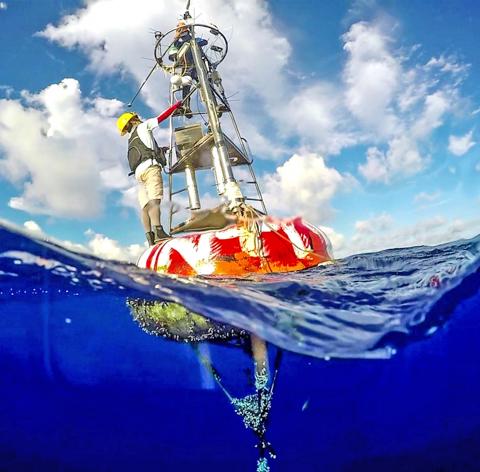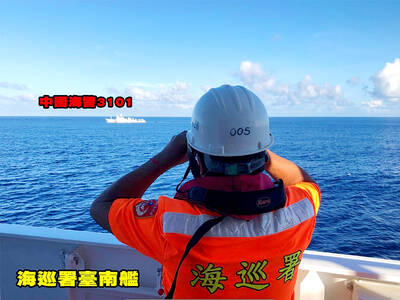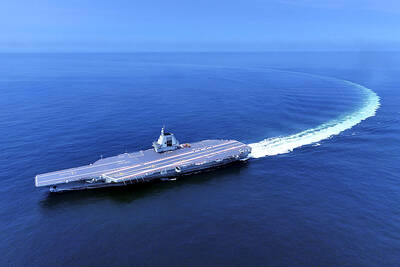A data buoy for weather and sea observations deployed by Taiwanese researchers was vandalized by unknown individuals, with the estimated losses of Taiwanese and US instruments reaching millions of New Taiwan dollars, National Taiwan University’s Institute of Oceanography said yesterday.
A team at the institute in 2015 started deploying two buoys (named NTU1 and NTU2) in waters 375km and 175km off the coast of Oluanpi (鵝鑾鼻) for collecting in-situ data of air and sea conditions to improve typhoon forecasts, institute associate professor Yang Yiing-jang (楊穎堅) said.
The buoys have resisted 14 typhoons, thanks to their solid anchoring 5.5km below the surface, he said.

Photo courtesy of National Taiwan University’s Institute of Oceanography
However, the team last month found the NTU1 buoy had unexpectedly drifted away from its position, and they immediately convened members to board Ocean Researcher I to look for it, he said.
They first retrieved the buoy’s surface floating base and meteorological tower in waters near the contiguous zone of the Philippines, while the buoy was found cut off from the 6m part of its underwater cable, he said.
The cut was neat and likely to have been done by some mechanical cutter, instead of being pulled off by force, he added.
In a second mission, the team on Wednesday reached the buoy’s original position and used an acoustic transponder to locate its underwater instruments, but nothing more was recovered, Yang said.
They had to suspend the mission due to high seas caused by the approaching Typhoon Hagibis, he added.
Attached to the NTU1 buoy’s underwater cable are instruments belonging to the institute, the Central Weather Bureau (CWB) and their collaborators at Oregon State University, Yang said, estimating the financial losses amount to millions of NT dollars.
They are more concerned about losing valuable data, as US turbulence probes had collected unprecedented data near the centers of the eyes of several typhoons, but they were set at a self-recording mode, instead of a real-time transmitting mode, he said.
Despite the setbacks, the team would seek to recover the underwater instruments again, possibly with the help of high-resolution sonar systems, he said.
While it is the first time the team encountered such a mishap, similar incidents have been reported in different corners of the world, while buoys deployed remotely from populated land areas are less likely to be wrecked, he said, adding that their NTU2 buoy remains intact.
They still do not know the real perpetrator, but continue working with the government to communicate with local seafarers and fishers, he said.
Such vandalism can be said to harm others without benefiting oneself, as perpetrators might endanger their own safety, institute director Jan Sen (詹森) said.
However, it is part of the risks that oceanographers have to face, Jan said, adding that the institute continues supporting such altruistic monitoring missions of typhoons using the buoys.
Yang, Jan and CWB officials next week are to visit the National Data Buoy Center and the Pacific Marine Environmental Laboratory at the US National Oceanic and Atmospheric Administration, hoping to gather more advice for preventing buoy vandalism, they said.

The Coast Guard Administration (CGA) yesterday said it had deployed patrol vessels to expel a China Coast Guard ship and a Chinese fishing boat near Pratas Island (Dongsha Island, 東沙群島) in the South China Sea. The China Coast Guard vessel was 28 nautical miles (52km) northeast of Pratas at 6:15am on Thursday, approaching the island’s restricted waters, which extend 24 nautical miles from its shoreline, the CGA’s Dongsha-Nansha Branch said in a statement. The Tainan, a 2,000-tonne cutter, was deployed by the CGA to shadow the Chinese ship, which left the area at 2:39pm on Friday, the statement said. At 6:31pm on Friday,

The Chinese People’s Liberation Army Navy’s (PLAN) third aircraft carrier, the Fujian, would pose a steep challenge to Taiwan’s ability to defend itself against a full-scale invasion, a defense expert said yesterday. Institute of National Defense and Security Research analyst Chieh Chung (揭仲) made the comment hours after the PLAN confirmed the carrier recently passed through the Taiwan Strait to conduct “scientific research tests and training missions” in the South China Sea. China has two carriers in operation — the Liaoning and the Shandong — with the Fujian undergoing sea trials. Although the PLAN needs time to train the Fujian’s air wing and

Taiwanese celebrities Hank Chen (陳漢典) and Lulu Huang (黃路梓茵) announced yesterday that they are planning to marry. Huang announced and posted photos of their engagement to her social media pages yesterday morning, joking that the pair were not just doing marketing for a new show, but “really getting married.” “We’ve decided to spend all of our future happy and hilarious moments together,” she wrote. The announcement, which was later confirmed by the talent agency they share, appeared to come as a surprise even to those around them, with veteran TV host Jacky Wu (吳宗憲) saying he was “totally taken aback” by the news. Huang,

The American Institute in Taiwan (AIT) put Taiwan in danger, Ma Ying-jeou Foundation director Hsiao Hsu-tsen (蕭旭岑) said yesterday, hours after the de facto US embassy said that Beijing had misinterpreted World War II-era documents to isolate Taiwan. The AIT’s comments harmed the Republic of China’s (ROC) national interests and contradicted a part of the “six assurances” stipulating that the US would not change its official position on Taiwan’s sovereignty, Hsiao said. The “six assurances,” which were given by then-US president Ronald Reagan to Taiwan in 1982, say that Washington would not set a date for ending arm sales to Taiwan, consult